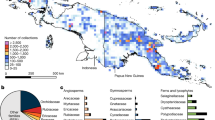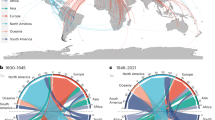Abstract
Field photographs of plant species are crucial for research and conservation, but the lack of a centralized database makes them difficult to locate. We surveyed 25 online databases of field photographs and found that they harboured only about 53% of the approximately 125,000 vascular plant species of the Americas. These results reflect the urgent need for a centralized database that can both integrate and complete the photographic record of the world’s flora.
This is a preview of subscription content, access via your institution
Access options
Access Nature and 54 other Nature Portfolio journals
Get Nature+, our best-value online-access subscription
$29.99 / 30 days
cancel any time
Subscribe to this journal
Receive 12 digital issues and online access to articles
$119.00 per year
only $9.92 per issue
Buy this article
- Purchase on Springer Link
- Instant access to full article PDF
Prices may be subject to local taxes which are calculated during checkout

Similar content being viewed by others
References
Wen, J., Ickert-Bond, S. M., Appelhans, M. S., Dorr, L. J. & Funk, V. A. Collections-based systematics: opportunities and outlook for 2050. J. Syst. Evol. 53, 477–488 (2015).
Ulloa Ulloa, C. et al. An integrated assessment of the vascular plant species of the Americas. Science 358, 1614–1617 (2017).
León, B. et al. Libro rojo de las plantas endémicas del Perú. Revista Peruana de Biología 13, 1–976 (2006).
ter Steege, H. et al. Hyperdominance in the Amazonian tree flora. Science 342, 1243092 (2013).
Leodegario, M. M. et al. Tillandsia itatiensis: a new species of Tillandsia L. (Bromeliaceae) from Bahia. Braz. Phytotaxa 456, 186–194 (2020).
Raven, P. H. et al. The distribution of biodiversity richness in the tropics. Sci. Adv. 6, eabc6228 (2020).
Parr, C. S. et al. The Encyclopedia of Life v2: providing global access to knowledge about life on Earth. Biodivers. Data J. 2, e1079 (2014).
Gries, C., Gilbert, E. E. & Franz, N. M. Symbiota: a virtual platform for creating voucher-based biodiversity information communities. Biodivers. Data J. 2, e1114 (2014).
Joly, A. et al. Interactive plant identification based on social image data. Ecol. Inform. 23, 22–34 (2014).
Lendemer, J. et al. The Extended Specimen Network: A strategy to enhance US biodiversity collections, promote research and education. BioScience 70, 23–30 (2020).
Baskauf, S. J. & Kirchoff, B. K. Digital plant images as specimens: toward standards for photographing living plants. Vulpia 7, 16–30 (2008).
Wilkinson, M. et al. The FAIR guiding principles for scientific data management and stewardship. Sci. Data 3, 160018 (2016).
Lin, D. et al. The TRUST principles for digital repositories. Sci. Data 7, 144 (2020).
Carroll, S. R. et al. The CARE principles for indigenous data governance. Data Sci. J. 19, 43 (2020).
Chamberlain, S. Spocc: interface to species occurrence data sources. R package version 0.9.0 (2018); https://CRAN.R-project.org/package=spocc
Barve, V. & Hart, E. Rinat: access iNaturalist data through APIs. R package version 0.1.5 (2017); https://CRAN.R-project.org/package=rinat
R Core Team. R: a language and environment for statistical computing. (R Foundation for Statistical Computing, 2019); https://www.R-project.org/
Boyle, B. et al. The taxonomic name resolution service: an online tool for automated standardization of plant names. BMC Bioinform. 14, 16 (2013).
The Plant List version 1.1 (The Plant List, accessed 5 March 2020); http://www.theplantlist.org/
Wickham, H. Stringr: simple, consistent wrappers for common string operations. R package version 1.4.0 (2019); https://CRAN.R-project.org/package=stringr
Wickham, H., François, R., Henry, L. & Müller, K. Dplyr: a grammar of data manipulation. R package version 0.8.5 (2020); https://CRAN.R-project.org/package=dplyr
Wickham, H. & Henry, L. Tidyr: tidy messy data. R package version 1.0.2 (2020); https://CRAN.R-project.org/package=tidyr
Warnes, G. R., et al. Gplots: various R programming tools for plotting data. R package version 3.0.3 (2020); https://CRAN.R-project.org/package=gplots
Larsson, J. Eulerr: area-proportional Euler and Venn diagrams with ellipses. R package version 6.1.0 (2020); https://cran.r-project.org/package=eulerr
Acknowledgements
We thank the thousands of photographers who have contributed photographs to the online resources surveyed in this paper, and the dozens of museums, universities, government agencies that maintain those resources. We thank R. Foster and T. Wachter for initiating the live plant photos and field guides projects at the Field Museum; the Field Museum IT and data management teams, especially S. Grant, K. Webbink, P. Herbst and J. Jones, for their work databasing and sharing the Museum’s field photographs; and N. Hensold for her heroic curation of their constantly evolving taxonomy. The following Field Museum volunteers carried out Google Image searches of individual species: M. Heisley, U. Major, S. Brangman and P. Hu. This publication received support from the Field Museum’s Grainger Bioinformatics Center. We thank the University of Basel, owner of the World Orchid Iconography database, and the Swiss Orchid Foundation, who facilitated its development. F.L.R.F. acknowledges a senior postdoctoral grant from FAPERJ (E-26/201.562/2018—process 236717). R.C.F. was supported by research grants from CNPQ (303420/2016-2) and FAPERJ (E-26/202.778/2018). E.H.S. acknowledges a postdoctoral grant from CAPES (PNPD/UFRB-88882.315208/2019-01).
Author information
Authors and Affiliations
Contributions
N.C.A.P. and T.S. conceived the study. N.C.A.P., T.S., C.U.U., J.M., J.S., J.P., C.F.V., A.D.L., P.B., A.J., M.W.T., J.H.B., J.P.J., K.C.N., B.M.T., M.T., E.E.G., R.C.F., G.Z., F.L.R.F., R.T., F.O.Z., M.J.B., C.A.Z., J.M.d.V., E.L.H.G., C.E.T.P., R.T.d.Q. and K.R. contributed photographic databases. S.P. queried the Flickr database. C.U.U. provided the taxonomic backbone for the analyses. T.S. assembled the master photographic database, standardized the taxonomy of contributed databases and carried out statistical analyses. T.S. supervised the four Field Museum volunteers who assisted in data collection. N.C.A.P. and T.S. wrote the paper. T.S. prepared Fig. 1a. N.C.A.P. prepared Fig. 1b. T.S. prepared the Supplementary Tables. All authors discussed the results and implications of the analyses, commented on the manuscript at all stages and contributed revisions.
Corresponding author
Ethics declarations
Competing interests
The authors declare no competing interests.
Additional information
Peer review information Nature Plants thanks Sabina Leonelli and Pamela Soltis for their contribution to the peer review of this work.
Publisher’s note Springer Nature remains neutral with regard to jurisdictional claims in published maps and institutional affiliations.
Supplementary information
Supplementary Information
Supplementary Fig. 1 and title and captions for Tables 1–4.
Supplementary Table 1
The 25 online resources surveyed during this research and 13 other online resources consulted but not surveyed. For all columns, ‘species’ refers to vascular plant species of the Americas (North America, South America, Central America and the Caribbean)2.
Supplementary Table 2
Species-by-resource matrix, indicating which vascular plant species of the Americas (North America, South America, Central America and the Caribbean)2 are represented in each of the 25 online resources surveyed during this research. Species names are sorted first by the total number of resources containing that species, in descending order and then alphabetically.
Supplementary Table 3
Number of species found for each region of the Americas in 25 surveyed online resources of field photographs of plants and the proportion of regional floras found in each resource. Regions and region data are from Ulloa Ulloa et al.2. Resources are sorted by median number of species in each region, in descending order.
Supplementary Table 4
Number of species per family in each resource, proportion of VPA family diversity in each resource, and number and proportion of species per family not found in any resource. For all columns, ‘species’ refers to vascular plant species of the Americas (North America, South America, Central America and the Caribbean)2.
Rights and permissions
About this article
Cite this article
Pitman, N.C.A., Suwa, T., Ulloa Ulloa, C. et al. Identifying gaps in the photographic record of the vascular plant flora of the Americas. Nat. Plants 7, 1010–1014 (2021). https://doi.org/10.1038/s41477-021-00974-2
Received:
Accepted:
Published:
Issue Date:
DOI: https://doi.org/10.1038/s41477-021-00974-2



